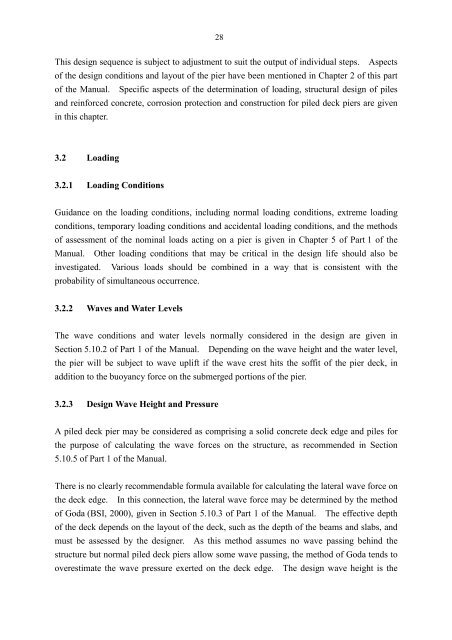Port Works Design Manual : Part 2
Port Works Design Manual : Part 2
Port Works Design Manual : Part 2
- No tags were found...
You also want an ePaper? Increase the reach of your titles
YUMPU automatically turns print PDFs into web optimized ePapers that Google loves.
28This design sequence is subject to adjustment to suit the output of individual steps. Aspectsof the design conditions and layout of the pier have been mentioned in Chapter 2 of this partof the <strong>Manual</strong>. Specific aspects of the determination of loading, structural design of pilesand reinforced concrete, corrosion protection and construction for piled deck piers are givenin this chapter.3.2 Loading3.2.1 Loading ConditionsGuidance on the loading conditions, including normal loading conditions, extreme loadingconditions, temporary loading conditions and accidental loading conditions, and the methodsof assessment of the nominal loads acting on a pier is given in Chapter 5 of <strong>Part</strong> 1 of the<strong>Manual</strong>. Other loading conditions that may be critical in the design life should also beinvestigated. Various loads should be combined in a way that is consistent with theprobability of simultaneous occurrence.3.2.2 Waves and Water LevelsThe wave conditions and water levels normally considered in the design are given inSection 5.10.2 of <strong>Part</strong> 1 of the <strong>Manual</strong>. Depending on the wave height and the water level,the pier will be subject to wave uplift if the wave crest hits the soffit of the pier deck, inaddition to the buoyancy force on the submerged portions of the pier.3.2.3 <strong>Design</strong> Wave Height and PressureA piled deck pier may be considered as comprising a solid concrete deck edge and piles forthe purpose of calculating the wave forces on the structure, as recommended in Section5.10.5 of <strong>Part</strong> 1 of the <strong>Manual</strong>.There is no clearly recommendable formula available for calculating the lateral wave force onthe deck edge. In this connection, the lateral wave force may be determined by the methodof Goda (BSI, 2000), given in Section 5.10.3 of <strong>Part</strong> 1 of the <strong>Manual</strong>. The effective depthof the deck depends on the layout of the deck, such as the depth of the beams and slabs, andmust be assessed by the designer. As this method assumes no wave passing behind thestructure but normal piled deck piers allow some wave passing, the method of Goda tends tooverestimate the wave pressure exerted on the deck edge. The design wave height is the
















